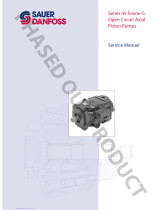
Application
The KVE is intended as a direct replacement for the MCV111. But when 2 or more EDC are used in a
vehicle propel application they should all be of one type or the other, don’t mix them for reasons as
described in this application section. The KVE and MCV use a torque-motor based electrical actuator
scheme that is designed to work with a current (dc mA) signal, i.e., 75 mA will produce the same pump
flow every time. However, the KVE and MCV have different electrical coil arrangements, resulting in the
following precautions:
•
Both are dual coil, but have different coil values (KVE 16Ω and 20Ω/MCV 25Ω and 25Ω). This may
cause problems in applications where there is a mix of KVE and MCV, they are controlled
simultaneous and electrically tied together in a parallel arrangement. In those parallel circuits the KVE
pump will be stroked ahead of the MCV by approximately 25%. Therefore to ensure that KVE and
MCV pumps stroke at the same rate use a series electrical connection, which will ensure that all EDCs
receive the same electrical current.
•
The MCV coils are arranged on a T-bar-style armature. This allows the coils to be physically separated
by a small air gap. The KVE coils are arranged on a stand-up style armature (which is the same used on
all other dual coil EDCs and servovalves) and they are stacked one atop the other. In some rare
instances, this may induce current changes resulting from the magnetic effects of one coil on another
(see Precautions When Driving Dual Coil PCPs With A PWM Drive). Contact Danfoss for applications
concerns.
KVEBXXXXX REPLACES KVEAXXXXX
The new control will be identified by a new letter in the control part number. The control will be
designated KVEB, whereas the previous control p/n was designated as KVEA.
When servicing the new EDC, a different pilot valve part number will be required (as compared to the
existing EDC) when replacement is necessary.
As a product improvement, design changes to the Series 90 Electric Displacement Control have been
made:
•
Improvements in the area of the control spool and feedback mechanism.
•
Revisions in the nozzle area/clearance with related part of the pilot valve.
These changes will not affect form or fit. In nearly all cases, function is not affected. There is one
exception:
When one side of the pilot valve is tapped to utilize the absolute pressure to pilot external devices such
as a one line motor control (see details below).
•
Abnormal case drain pressures.
•
Oil cleanliness.
This change went into effect January 1, 1999. Various pump frame sizes may incorporate this change at
different times dependent upon the manufacturing location and initial control availability.
One line motor controls: It is always best to use a two line motor control when phasing a variable motor
hydraulically with a Series 90 pumps (via the X1 and X2 ports). Applications using only a one line
hydraulic control rely on controlling the variable motor with pressure from only one of the EDC ports,
either X1 or X2, but not both. The pump phasing in these applications will be adversely affected by this
EDC change. Although the delta pressure (X1 - X2) versus coil current is not affected by this change, the
individual gage pressures at X1 and X2 are significantly reduced. Depending on fluid temperature and
viscosity, and the pump charge pressure setting, this reduction in gage pressures will be in the range of
60 - 80 psig (current range of 120 - 160 psig).
If no change is made to the motor control threshold, and/or ramp in a one-line controlled motor, the
motor shift will not occur until coil current reaches much higher levels. In fact, it may not even be
possible to fully shift the motor with any coil current level. Therefore, any applications phasing a one-line
Technical Information
KVEB Electrical Displacement Control for Series 90 Pumps
Design Parameters
10 BLN-95-9060 • Rev CA • April 2015





















